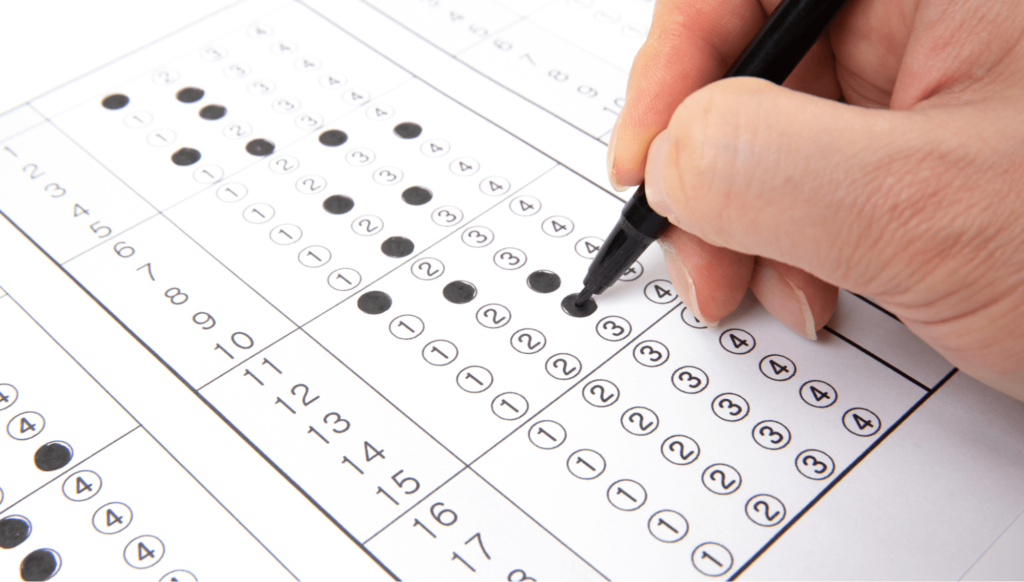Negative Marking in NEET 2025 & How to Avoid It
Did you know that a few wrong guesses can cost you a seat in your dream medical college?
If you’re preparing and aiming to crack NEET 2025, you already know how competitive it is. Every single mark counts, and sometimes, losing marks hurts more than gaining them. For this, negative marking is the real culprit. Because it can drag down your rank even when you have a solid grasp of the concepts.
Have you ever attempted a question, feeling half-sure, only to realize later that you got it wrong? That’s where negative marking plays its tricky role.
But don’t worry because you’re not alone. Many students struggle with this, but the good news is that you can avoid these mistakes during your NEET preparation. And minimize your negative score with the right approach.
How negative marking works in NEET 2025

Before we dive into how to avoid negative marking, let’s quickly understand how it works.
- Every correct answer gives you +4 marks
- Every incorrect answer deducts 1 mark
- Unanswered questions carry 0 marks
This means that just four wrong answers can cancel out one fully correct response. And when thousands of students are competing for limited seats, even a small mistake can make a huge difference in your rank.
Why most students lose marks unnecessarily
Negative marking doesn’t always happen because you don’t know the answer. In fact, many times, it’s just small mistakes that cost you marks.
Here are some common reasons why students lose marks unnecessarily:
Guessing without logic

We’ve all been there. You come across a tough question, and instead of skipping it, you take a wild guess. “Maybe option B looks right?” or “Let’s just pick C and move on.”
While this might work once or twice, it’s not a reliable strategy. In fact, random guessing usually results in more lost marks than gained ones. The problem is that NEET options are designed to be tricky. Even if you feel like one of them “looks familiar,” that doesn’t mean it’s correct.
Overconfidence

Confidence is great—but overconfidence? Not so much. Many students mark answers quickly, assuming they know the correct response without double-checking.
This often leads to:
- Tiny calculation errors in physics and chemistry
- Overlooking key details in biology
- Misreading words like “not,” “except,” or “true/false”
NEET questions are tricky by design. Sometimes, a question might seem straightforward, but a small twist in wording can change everything.
Related blog
📌 How to prepare for NEET from class 11
Rushing through the paper

You look at the clock, and suddenly you panic. This happens as NEET is a time constraint exam. Don’t panic because you may still have several questions left, and instead of solving them carefully, you start marking answers in a hurry.
This is one of the biggest reasons students lose marks unnecessarily. Under pressure, you’re more likely to:
- Misread the question
- Make careless mistakes
- Skip essential steps in calculations
Misreading questions

NEET is famous for its tricky question phrasing. A single word—like “except,” “not,” or “false”—can completely change what the question is asking. Many students lose marks just because they misinterpret the question.
For example, you might see:
- “Which of the following is not a function of the liver?”
- Bile production
- Detoxification
- Red blood cell production
- Glycogen storage
- All of the following statements about DNA replication are true, except:
- It occurs in the nucleus of eukaryotic cells.
- It follows the semi-conservative model.
- It requires RNA primers.
- It occurs during mitosis.
Related blog
📌 How to study biology for NEET
If you skim through the question too quickly, you might overlook “EXCEPT” and choose a correct fact about DNA replication rather than the incorrect statement.
Reading carefully is key to avoiding these costly mistakes!
Filling the OMR sheet in a hurry

You’ve done the hard work. Solved the question, figured out the answer. But then, in a rush, you mark the wrong option on the OMR sheet. Or started marking from a different question. Or worse, you accidentally fill two bubbles instead of one.
It sounds like a silly mistake, but it happens way too often. And the worst part? There’s no way to fix it once you’ve filled in the bubble.
How to avoid negative marking in NEET 2025
Now that you know what causes negative marking, let’s talk about how to prevent it.
Prioritize questions for which you know answers first

When you sit for the NEET exam, time is your biggest enemy. Every second counts, and you don’t want to waste precious minutes struggling over tricky questions when there are easier ones waiting to be answered.
Start with the questions you know for sure. This helps you build momentum, boosts your confidence, and ensures you secure those marks first. Once you’ve covered the easy ones, you can return to the tougher questions with a clearer mind and a more strategic approach.
Many students make the mistake of attempting the paper in sequence, but that’s not necessary. The exam doesn’t care which questions you answer first. It only cares how many you get right.
So, be smart with your approach—start strong, secure easy marks, and then battle the difficult ones.
Use the elimination technique

How often have you been stuck between two options, feeling like both could be correct?
This is where most students panic and either overthink or make a blind guess. Both of which can lead to negative marking.
A smarter way to handle this situation is by eliminating the wrong choices first. Let’s say you don’t know the exact answer, but you know for sure that two options are incorrect. That leaves you with a 50% chance of picking the right answer, which is way better than random guessing.
Many NEET questions are designed with distractors. Means answers that seem correct but contain a slight twist. Instead of diving straight into solving, see the options before answering. If an answer seems too extreme or doesn’t fit logically, cross it out and focus on the remaining choices.
By training yourself to spot these distractors during practice tests, you’ll find it much easier to avoid negative marking in the actual NEET exam. The key is to think like the examiner—why would they put that option there? Once you start recognizing these patterns, choosing the right answer becomes a cakewalk.
Related blog
📌 Best coaching institutes for NEET in Pune
Don’t over-attempt questions

Many students think that answering all questions will help them score higher. But in reality, this can do more harm than good.
Imagine this: You answer 140 questions correctly and leave 10 blank. Another student answers all 150 but gets 10 wrong. Because of negative marking, the second student loses 10 marks, while your score stays safe. That small difference could decide whether you get into your dream college or not.
Note it down. Skipping a question isn’t a failure. It’s a smart choice when you have no clue. If you can’t eliminate any wrong options, it’s better to leave the question blank than to guess and lose marks.
Of course, this doesn’t mean you should skip questions too easily. If you can make an educated guess, go for it! But if you have no idea, don’t let overconfidence push you into guessing randomly. Every wrong answer costs marks, so choose wisely.
Practice mock tests like the real exam

The way you practice determines the way you perform in the actual exam. If you casually attempt mock tests without simulating real exam conditions, you won’t build the right habits.
Think about it—when you solve a test at home, do you take long breaks, check your phone, or reattempt questions? That’s not how it works in the exam hall. To truly benefit from mock tests, you need to treat them as seriously as the real thing.
- Set a timer and complete the test in one go.
- Use an OMR sheet to get comfortable with marking answers correctly.
- Analyze your mistakes afterward—not just what went wrong, but why it went wrong.
- Keep track of negative marking and see where you lose the most marks.
Mock tests are your training ground. The more you practice with discipline, the more natural it will feel in the actual exam. Aim for at least 10-15 full-length mock tests before NEET 2025. By the time you sit for the real exam, you should feel like you’ve already done it a dozen times before.
Read the questions carefully

This might sound like basic advice, but misreading questions is one of the biggest reasons students lose marks. In the rush to finish the paper, many students skim through questions and end up answering something completely different from what was actually asked.
Let’s take an example. If a question asks:
“Which of the following is not a characteristic of enzymes?”
Your brain might skim through it as “Which of the following is a characteristic of enzymes?” and pick the wrong option. That one missed word—”NOT”—costs you marks.
Exam pressure can make even simple words look different, so here’s a tip:
- Read the question twice before answering.
- Underline key words like ‘except’, ‘not’, ‘true’, ‘false’ to avoid confusion.
- If a question looks too easy, double-check—sometimes, it’s a trap.
When you’re in the exam hall, don’t rush just to save time. A few extra seconds spent understanding a question properly can save you from unnecessary negative marking.
Exam day strategies to keep negative marking in check

Even if you prepare well, the real test is how you handle the pressure on exam day. Here are a few tips to boost your NEET ranking. So keep these things to keep in mind.
- Read the questions carefully—understand what’s asked before selecting an answer.
- Manage your time—allocate time wisely and keep track of the clock.
- Avoid oral calculation—write down necessary steps to minimize errors.
- Fill the OMR sheet carefully—ensure correct markings to avoid mistakes.
- Don’t get stuck—if a question seems difficult, move on and return later if time allows.
- Stay calm and focused—panic can lead to unnecessary errors.
- Review your answers—if time permits, double-check for any mistakes.
Negative marking in NEET: Smart strategies to minimize score deduction!
Negative marking in NEET can make or break your final score. Every incorrect answer deducts 1 mark, which means guessing blindly can cost you valuable points. To maximize your score and minimize deductions, follow these smart strategies:
✅ Attempt what you know first – Prioritize questions you are confident about before moving to uncertain ones.
✅ Avoid random guessing – If you’re unsure, eliminate wrong options and make an informed choice rather than guessing blindly.
✅ Manage your time wisely – Don’t rush, but also don’t spend too much time on a single question.
✅ Stay calm and focused – Panicking leads to mistakes. Keep a clear mind and attempt each question strategically.
✅ Fill the OMR sheet carefully – Mark answers correctly to avoid last-minute errors that could cost you marks.
At Chaitanya’s Academy–one of the best NEET institutes in India—we help students master these strategies through expert guidance, mock tests, and result-oriented training.

Our structured approach ensures you develop accuracy, confidence, and time management skills—key factors to excel in NEET while avoiding negative marking pitfalls.
Join Chaitanya’s Academy today and boost your NEET preparation with expert coaching and proven strategies! 🚀




